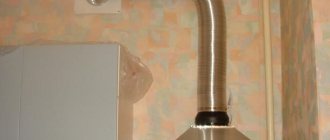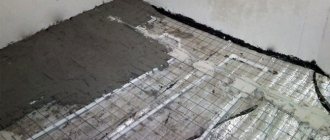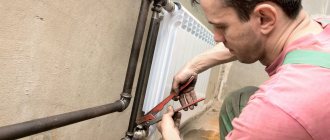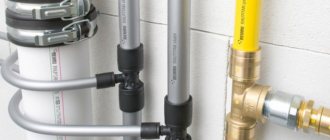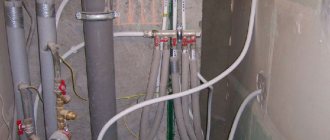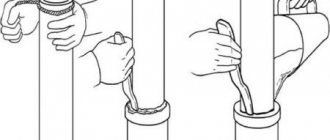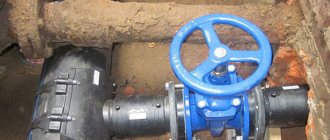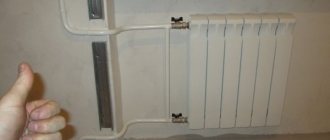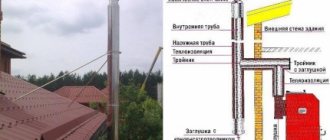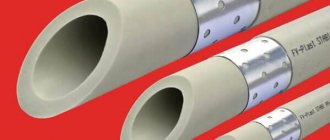Purpose and principle of operation
Plugs shut off the water supply to a certain section of the water supply.
A plug is a special fitting that can be used to shut off the water supply to the system at a certain section of it. The element has the shape of a circle or square. The latter are rarely used for plumbing work.
The plug is used for the following purposes and in the following situations:
- Protection of the inside of the pipe from moisture and dirt, penetration of rodents and insects. This option is observed when installing fence posts made from round/square tubes.
- Suppression of a plastic water pipe or metal/polymer sewer pipe at the time of plumbing repair work in the system (installation/dismantling of its individual elements).
- Protection of tubes from the ends during their transportation.
To plug the gas pipeline, special flange plugs are used. They are subject to repeated installation/dismantling.
Any plug works on the principle of completely sealing the pipe opening. It is a kind of traffic jam. If it is necessary to extend the system (sewage, gas or water supply), the plug is simply removed from its place.
How to plug a water pipe
The procedure itself is simple, and if you have basic knowledge and skills in the repair and construction field.
Those who have not encountered plumbing work should adhere to the following recommendations:
- Threaded connections are sealed using FUM tape. This is necessary for sealing.
- Before plugging the water pipe, you need to turn off the ball valve and cut it off from the supply system.
- The welding machine must be used in accordance with safety requirements.
- If a flange plug is installed, the bolts must be the same size as the holes made.
A decorative plug works on the same principle as a regular one, and therefore, during installation, all requirements must be met. The technology for installing fittings differs depending on the pipeline materials.
Metal pipe
Metal is different in that such a pipe can be threaded, welded (except for cast iron), flanges can be installed, which means any methods can be used. You need to choose one that has all the necessary tools at hand. Plugs are made from different materials, and the choice depends on what kind of subpipe it is.
READ ALSO: IS IT NECESSARY TO CLEAN REINFORCED POLYPROPYLENE PIPES DURING THE INSTALLATION PROCESS? PLASTCOM GROUP
Cast iron pipe can be terminated with flanged fittings. The welding machine is useless; cutting threads will not work. In this case, sealing is performed with cotton fiber. Steel is a more malleable metal, and all those methods that are not available in the case of cast iron can now be applied.
To plug such a pipe, you can use:
- Metal spherical plugs. Used for water pipelines, gas pipelines, oil pipelines.
- Flange devices. Cold water pipes are sealed with a rubber gasket, hot water pipes are sealed with paronite.
- Pneumatic plugs. They are used to eliminate emergency situations in production and in household support systems.
- Decorative fittings. This is the case if the main task is not to maintain pressure in the pipeline, but the appearance of the structure.
The last category includes products made of plastic, rubber, and metal. Regarding copper pipes, it must be added that welding is possible, but the technology requires the use of special devices and materials. Copper is a soft metal. You can cut the thread, but you need to tighten it very carefully.
Plastic pipe
Technologically, measures for end sealing of plastic pipes are divided into two categories. The first includes methods that involve soldering or gluing a plug and a pipe. Installing the plug in this way means that it can only be cut off later. The second method is temporary and involves the possibility of dismantling.
READ ALSO: Fastening polypropylene pipes: how to fasten them to the wall, clamp, clamp, fasteners, installation options
Plastic that is used without internal pressure can be jammed with decorative (for example, rubber) fittings. When it is important to maintain tightness, adhesives are used. The choice depends on the type of plastic. Such pipes are not designed for high pressure. Therefore, if we are talking about a water pipe, then it will most likely be a polyethylene pipeline.
Polyethylene pipe
Sometimes it is necessary to urgently plug the pipeline. In this case, a special fitting with internal thread is used, which is also made of polyethylene. You will need a die. With which an external thread is cut at the end of the pipe. The plug will need to be screwed onto it, but the connection is first sealed with FUM tape.
Experts recommend only one method for permanent plugs - welding. Polyethylene is soldered using a special apparatus that heats the contacting elements to a temperature where connections at the molecular level are possible. It is impossible to remove such a plug. And if the time comes for depressurization, you will have to cut it off.
The technology involves the use of such a tool:
- hacksaw, grinder, etc.;
- deburring agents (rasps);
- cutting tools (knives);
- sealing compounds (silicone);
- construction hair dryer;
- special welding machine.
READ ALSO: Useful homemade products from plastic pipes
In most cases, you can do the work yourself if you have everything listed at hand.
Types of stubs
All fittings used to plug pipes are classified according to the material of manufacture, installation method and type of construction. Products are made from the following materials:
- Metal (brass, steel, cast iron elements). The fittings have a high tensile strength, therefore they are widely used in public highways (gas and water supply, sewerage). However, metal plugs are susceptible to corrosion. The exception is chrome steel fittings. This material does not rust. Metal fittings also include a special plug for sealing. It has a special technical hole for installing a seal. As a result, it will be impossible for third parties to interfere with the system.
- Polymers. Plastic plugs are widely used in private construction. The material does not rust or wear out. Polymer fittings are deformed under the influence of high temperatures (sun, hot water from +85 degrees). Polyethylene fittings are used for the internal pipe plug.
- Rubber. The simplest type of element, used either for decorative purposes or exclusively in private water supply.
According to their design, silencing fittings are divided into the following types:
- Threaded. The simplest of all plugs. They simply screw into or onto the pipe.
- Flanged. It is assumed that there are technical holes along the edge into which mounting bolts are driven. The flange plug is often attached to the casing or gas pipe using reinforced hardware (nuts/bolts). If necessary, the fitting can be removed at the right time. As a rule, the flange element is made of metal.
- Pneumatic. Made of rubber. You can install such an element using a pump by forcing air into it. The fitting has a special fitting with a hose. Air is pumped and pumped through it into the plug and back. Such an element can operate at temperatures from -40 to + 70 degrees. The peculiarity of a pneumatic fitting is that it will hermetically close the lumen of the pipe, regardless of the evenness of its inner walls.
- Elliptical. Installation is performed using welding.
Threaded internal
Flanged plastic
Pneumatic
Elliptical
Flanged brass
Threaded external
According to the type of installation, all plumbing elements for silencing are divided into two types:
- Internal. Mounted using special ribbed notches. The upper part of the fitting is covered with a lid.
- External. They work simultaneously as a decorative element and as a dampening element.
There are types of plugs according to their purpose - end and transportation. The first ones jam a section of the system. The latter are used to protect the ends of pipes during transportation. Their strength characteristics are seriously inferior to those of end caps.
The procedure for installing plugs on a gas pipeline
Installation of plugs can only be carried out by specialists who have permission to work with gas equipment. A person must know all instructions and follow safety rules.
Sometimes installing a stop plug on a gas pipe can be done independently. In the event that the local gas service technician turns off the gas in the pipeline. Often they allow you to do this yourself, but, again, with the permission of the city gas agency.
When working with gas, be sure to follow all safety rules, carry out welding work in special clothing and a welding mask to protect your eyes
You cannot smoke cigarettes or light a fire during the installation process of the plug. According to safety rules, gloves and special glasses should be used when working with gas. Under no circumstances should you light matches, and in general there should be no open fire in the room. It wouldn't hurt to organize ventilation.
Before you begin any work, you will have to find where in the house the device for measuring gas flow - the meter - is located. It is near the meter that you will find the main valve that can be used to shut off the gas in the room.
The valve usually looks distinctive, having a large rectangular handle. It is located on one of the pipes that are connected to the meter. And there are only two pipes. One of these pipes supplies gas to your home.
It happens that in an apartment building they use complex meters, here you will have to find your exact measuring device and turn off the gas in your apartment. It is important not to mix up the valve and not cut off the gas to one of the neighbors.
To stop the gas supply, the handle is left in a perpendicular position to the pipe. And in the open position, the valve is located parallel to the gas pipe
So, turning off the gas to your house or apartment is only the first part of the work; you will also have to free the pipe that you want to plug from other pipes or gas devices. Here you can use a special adjustable wrench that you can use to unscrew the pipe.
Next, we recommend the following steps:
- To release the pipe you will need not just one key, but two. One should hold one nut, and the other should gradually unscrew the other until the pipe is freed from the device connected to it.
- You may just need to cut off the pipe, depending on what cases you are going to install the plug for. For safety reasons, make sure once again that there are no leaks or smell of gas, and that you have turned off the correct valve.
- Next, clean the pipe, scrub it thoroughly with a hard steel wool, and remove any remaining dirt or grease from the threaded connections, if any. Pay special attention to the carving, make sure there is nothing unnecessary on it.
- If you are going to install an eternal plug - an elliptical one, then you just need to weld it to the pipe and that’s it, and then check with soap foam for gas leaks. Eliminate if any.
- Install a threaded plug like this - prepare Teflon tape so that there are not even the smallest gaps left between the threads of the plug and the threads of the pipe. Wind it onto the pipe thread, making turns only clockwise. Then, when tightening the thread, the gasket material will not unwind.
- It is advisable to use plugs made of the same material as the pipe. For a steel pipe, a brass or chrome-plated plug is also suitable. In the end, all that remains is to take the plug and screw it to the gas pipe.
Please note that you should not screw the locking product very tightly - this will not make the connection more reliable.
On the contrary, the plug can only fail, then a gas leak will occur, which is life-threatening.
When performing gas work, follow all safety precautions. Do not leave tools or equipment anywhere after work. Put everything back in its place
Only after cleaning and completing all work can you turn on the gas supply valve again. Be sure to check with a foamy detergent that everything is sealed and that there are no gas leaks at the connections between the plug and the pipe. If everything is in order, no bubbles will form at the junction.
Fitting selection criteria
The plug is selected according to several parameters:
- Material of manufacture. As a rule, PVC fittings are used for metal-plastic pipes, polyethylene for PET, and steel or brass for metal. Rubber ones are used as temporary ones.
- Diameter, size and shape. The cross-section of the plugs must exactly match the parameters of the communication pipes. In addition, round fittings are used for round elements, and square fittings are used for profile elements.
- Purpose. For long-term sealing of the pipe, it is better to buy a threaded or elliptical fitting. If the plug is installed for a short time, it is better to use a flange one. Moreover, it is not recommended to buy rubber and polymer plugs for the hot water system or heating pipes. They change their shape when exposed to high temperatures. As a result, system depressurization may occur. Pneumatic and threaded plugs are not installed on gas pipelines. It is better to use flanged ones here.
Decorative plugs are made from PET in various shades. The color is added to the polymer at the casting stage. The fitting is painted uniformly throughout the entire thickness of the plastic.
Principles and features of installation of various types of plugs
When screwing in the plug, it is important not to strip the thread.
The device for plugging the pipe can be installed in different ways, depending on its design features. The following actions are performed:
- Screwing in. This method is used to install a threaded fitting. Before installing it, you must use fum tape and sealant. They will additionally protect the system from leakage. The tape is wound in a small layer on the outer part of the fitting and screwed on. The threaded plug is screwed in by hand until it stops, but without excessive tension.
- Welding. Suitable if an elliptical element is being installed. It is possible to achieve complete tightness of communication. In this case, the work should only be carried out by a specialist. The welded plug is installed for a long period and is not suitable if any repair work is expected to be carried out on the communication section in the near future.
- Use of bolts and nuts. This method is used to install a flange muffler. Before installation, you need to place a seal between the fitting and the pipe. It, in turn, is selected in accordance with the permissible temperature values for a particular system and the pressure requirements in it.
- Air injection. The water supply plug can be installed in several stages. Water is removed from the pipe, a hole is made in the desired section of the system, a fitting is inserted and air is pumped into it. Expanding, the walls of the plug fit tightly to the inside of the pipe. Remove the pneumatic fitting upon completion of the repair work. To do this, you just need to pump out the air from the rubber stopper and remove it.
Thanks to a huge assortment of shut-off fittings, it is possible to solve the issue of sealing the pipeline and the decorative appearance of profile tubes used as fence posts. It is only important to make the right choice.
